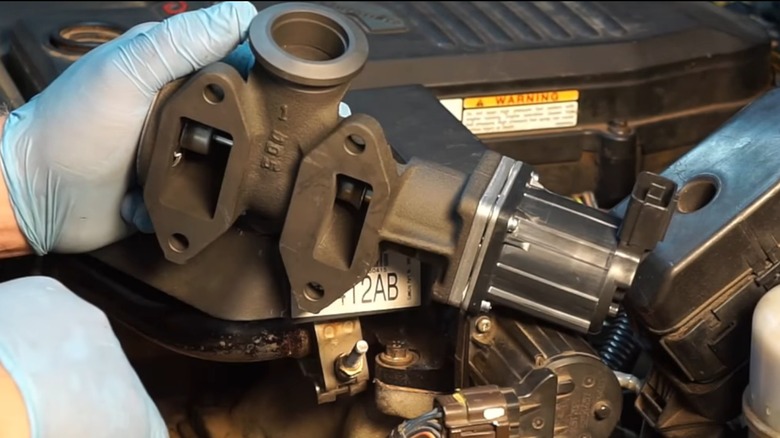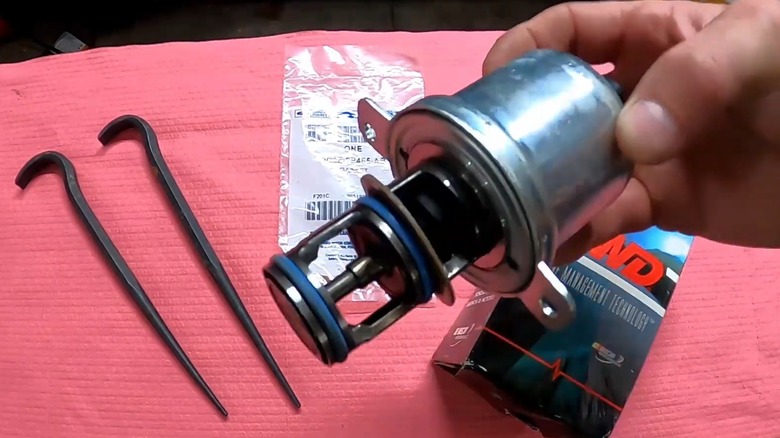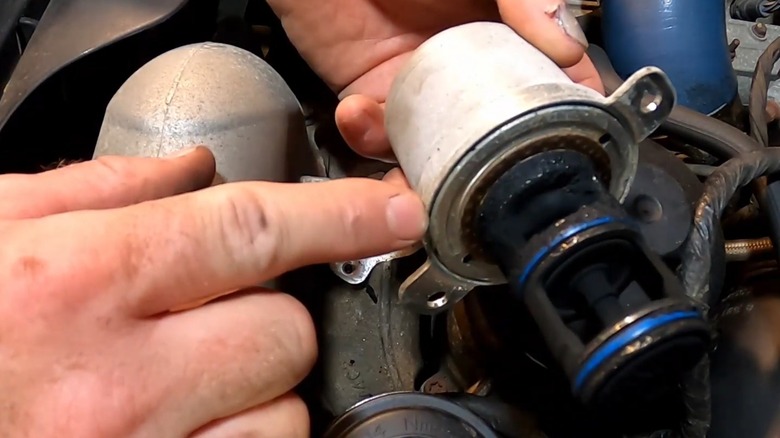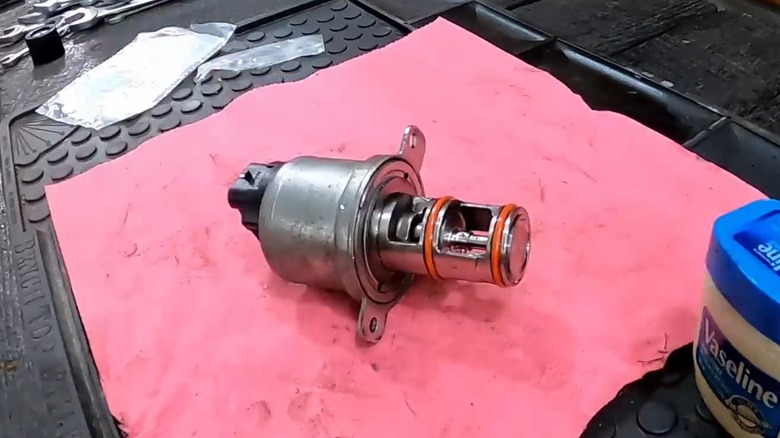What Is An EGR Valve And How Does It Work In A Diesel Engine?
Modern internal combustion engines — including those that run on diesel fuel — require a lot of special parts and systems to prevent dumping excess emissions into the atmosphere. Not only are those emissions harmful to the environment, resulting in less clean air to breathe and contributing to climate change, but they can also cause our vehicles to run less efficiently. One of the emissions control systems designed to combat both of those issues is the exhaust gas recirculation (EGR) system.
As the name implies, EGR systems are responsible for recirculating exhaust gasses back to the engine. These systems are necessary for two primary reasons: one is to recycle harmful emissions back through the engine to transform them into less harmful gasses, while the second reason is that no engine is 100% efficient, and sometimes, fuel passes through the system without burning. Unburned fuel and emissions are both harmful to the environment, and they both contribute to reduced fuel economy and efficiency.
Through the use of an EGR valve, the EGR system is able to recirculate those gasses and unburned fuel back through the engine. When that occurs, the system burns slower and cooler, preventing nitrogen from turning into toxic nitrogen-oxides or NOx and using any unburned fuel that recycles through. It's a lot more complicated than that, though. So, if you're curious about how the EGR valve works in your diesel engine, stick around. As a former professional mechanic and lifelong gearhead, I'll break it down for you. We'll cover the way EGR valves work, why they're important, and even a few signs of EGR valve failure. Let's dive in and check it out.
How does an EGR valve work in a diesel engine?
Your car's engine reaches extremely high temperatures under normal operating conditions. However, all that heat also comes with some downsides, including the production of harmful emissions. That's because the air that makes up our atmosphere is roughly 78% nitrogen and 21% oxygen. However, when that air gets sucked into our engines and combines with diesel or gasoline for combustion, the resulting explosions and incredibly high temperatures cause the nitrogen to convert into harmful nitrogen-oxides or NOx.
The EGR valve helps combat that issue and prevent the release of excess NOx into the atmosphere. As mentioned, its job is to reroute a specific amount of exhaust gasses back into the engine's combustion chambers. When that happens, the engine gets less oxygen, translating to a slower and cooler burn. Since the engine burns fuel at a lower temperature while the EGR valve is active, less nitrogen-oxides are produced, resulting in cleaner air and a more efficient engine.
To accomplish this feat, the EGR valve operates based on your current driving conditions. When you start your car and when you're driving at high speeds or accelerating, the engine requires more clean air to run smoothly. However, when you're idling or driving slowly, the engine doesn't need as much oxygen to perform properly. The EGR valve helps optimize your engine's performance and prevent the release of pollutants by opening and closing based on those conditions. It remains closed or nearly closed when your engine needs more air — like when starting up in the morning or accelerating to highway speed. However, if you're idling or driving at a steady low speed, the valve gradually opens up to begin recycling more exhaust gasses back through the engine.
What are some signs of EGR valve failure?
As mentioned, the EGR valve in your diesel engine is an important component, both for your vehicle's performance and the environment. However, like many other auto parts, it's subject to wear and tear over time and can fail or develop malfunctions. Considering that the average EGR valve has an estimated lifespan of around 10 years, you may have to replace yours at some point. So, it's a good idea to learn the signs of a failing EGR valve to stay ahead of any issues.
EGR valves are especially prone to carbon buildup. The issue can be caused by dangerous fuel contamination, a lack of regular maintenance, and age, and it can lead to clogs that restrict the flow of gasoline or diesel. However, EGR valves can also fail due to things like manufacturer's flaws, extreme operating temperatures, and incompatible parts. When any of those conditions are met, the EGR valve can display a range of symptoms. Some of the most common signs of EGR valve failure include things like a lit check engine light, engine knocking or pinging sounds, poor performance, reduced fuel economy, a rough idle, and a failed emissions test.
Each of those symptoms is bad for your vehicle. However, the tricky thing is that various mechanical malfunctions can cause those issues, either together or separately. So, if you encounter any of the problems described above, the smartest move is to visit a professional mechanic for an inspection and diagnosis.
How much does it cost to replace an EGR valve, and can you DIY it?
Now that you know more about EGR valves, including the fact that they may fail periodically, you may be wondering what it costs to replace one. It's a good question, but somewhat tricky to answer. That's because the price for an EGR valve replacement can vary greatly depending on the type of vehicle. While the price to replace an EGR valve on a standard gas-powered car can fall between $350 and $500, replacing the EGR valve on a diesel engine can cost substantially more. This is thanks to the high cost of parts and the labor-intensive replacement process. For example, replacing the valve on a Ford pickup truck with a Power Stroke diesel motor can cost upwards of $1,500, while various diesel owners across the country report facing similar prices.
Considering how costly it can be to replace an EGR valve, you might be curious if it's possible to DIY the replacement. It is possible to perform your own EGR valve replacement. However, if you're not a knowledgeable home mechanic or an experienced DIYer, you may struggle, especially if you own a diesel. That's because replacing the valve on a diesel engine tends to be more labor-intensive.
Most EGR valves are located near the intake and exhaust manifolds. While it can be relatively easy — but still annoying — to access the EGR valve on a smaller gas-powered vehicle, doing so on a larger diesel engine may require removing many parts to access the valve. That translates to a lot of labor time and technical work, which can be a bit much for inexperienced mechanics. That said, it's still possible to DIY an EGR valve replacement — just remember to do your research and try to invest in a vehicle-specific repair manual to guide you through the process.



